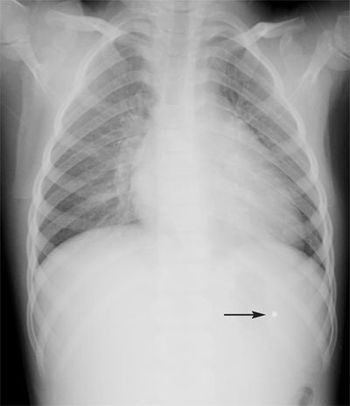
An adolescent girl seeks medical advice for managing recurrent nodules on her ear lobes. The diagnosis is keloids.

An adolescent girl seeks medical advice for managing recurrent nodules on her ear lobes. The diagnosis is keloids.

The world's best-known pediatrician, by a country mile, is still Benjamin Spock, MD, the author of The Common Sense Book of Baby and Child Care.

The Food and Drug Administration (FDA) recently approved several agents for use in pediatric patients, including a new cervical cancer vaccine and a seasonal influenza vaccine.

Profiles of exam table paper, baby bottles, nasal plugs.

Although the use of acetaminophen along with vaccination may reduce the incidence of fever in pediatric patients, a new analysis has demonstrated that this practice may also reduce the effectiveness of the vaccines.

Letter about smoking and web poll data.

Pediatric patients undergoing tonsillectomy are often given antibiotics after surgery to reduce pain. A new study has demonstrated that a 3-day course is as effective as a 7-day course.

A collection of links for all of the past CP Links in one spot.

The Institute of Medicine (IOM) has released new recommendations for school meal programs, setting maximum calorie levels for breakfast and lunch and recommending that the sodium content of meals should be gradually reduced over the next 10 years.

An article published in Contemporary Pediatrics 25 years ago instructed pediatricians on medications to treat attention deficit disorders (ADD). Their observations were so perceptive that, with a few tweaks, they could be republished as a 2009 update on attention deficit/hyperactivity disorder (ADHD).

A 12-month-old boy apparently had a seizure. He is no longer seizing and is reportedly stable.

The infant who arrives for medical care after an apparent life-threatening event (ALTE) presents the pediatrician with a host of uncertainties

Adolescent and young adult patients need help with the process of transitioning to adult care, in which patients are more responsible for their own healthcare.

Journal research looks at elevated BP in children who snore, leading treatments for lice and cause of colic.

A collection of links for the most current, comprehensive information on H1N1.

An editorial that examines the current status of H1N1 in the medical setting.

Dr Bhagwan Das Bang received the Pediatric Hero Award at The American Academy of Pediatrics (AAP) National Conference & Exhibition (NCE) in Washington, DC today (October 20, 2009).

Timothy Culbert, MD, and Rebecca Kajander, MPH, CNP, nearly put the audience to sleep at their October 18th interactive workshop, “Replacing Pills with Skills.” But that was just what they had hoped would happen!The two staff members from the Integrative Medicine Program at Children’s Hospital and Clinics in Minneapolis demonstrated-and then had the audience practice-a variety of self-care techniques that can be taught to children to help them manage common health problems, such as pain, insomnia, anxiety, and nausea.

Attorney General Eric Holder made a surprise appearance at Monday morning’s (Oct. 19) plenary session to talk to attendees at this year’s AAP Convention about the problem of children’s exposure to violence – and what pediatricians can do about it. His impassioned speech was met with a standing ovation from the packed DC Convention Center ballroom.

As our legislators craft their bills, the media is feeding us a relentless diet of health care debate coverage. TV, newspapers and journals, and the blogosphere report and opine tirelessly on questions of whether there will be a public option, how much health care reform will cost, how it wilil be financed, and others.

Pediatricians on their way to Washington, DC, for the American Academy of Pediatrics (AAP) 2009 National Conference & Exhibition this weekend (October 17-20) will likely have both a sense of anticipation and some concern.

For the discerning pediatrician, choosing which sessions to attend at the American Academy of Pediatrics National Conference & Exhibition (AAP NCE) can be a daunting task. The editors of Consultant for Pediatricians have prepared a list of “must-see” sessions to help narrow down the selection process.

There are 2 major reasons to vaccinate your child.

Given the array of childhood disorders that can adversely affect the immune system, most pediatricians at some point will care for children who are immunodeficient.

Vaccines have saved more lives than any other single medical advance and are among the most important preventive tools available to clinicians.

A 5-year-old girl was brought to the emergency department after she was injured during a drive-by shooting. She had 5 small entry wounds: 2 in the arm, 2 in the buttocks, and 1 in the left torso. Radiographs confirmed that a piece of pellet had entered her upper torso but was not in the lung or causing any problem.

A review of three articles, about media exposure's link to increased BMI, a better test for tuberculosis, and how parents may be put off if you don't greet them properly.

Communities that use science-based approaches to problem behaviors in adolescents, including alcohol and tobacco use, are more likely to see positive results.

Profiles of a portable table, a pediatric gait trainer, and a software program that uses RFID tags to track nursery infants.

A 12-month-old awakens with asymptomatic juicy red papular eruptions on her cheeks. It is diagnosed as Gianotti-Crosti Syndrome.